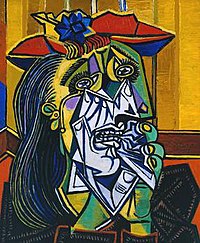
Back المرأة الباكية Arabic زن گریان Persian La Femme qui pleure (Picasso) French האישה הבוכה HE Žena koja plače Croatian Donna che piange Italian 泣く女 Japanese വീപ്പിംഗ് വുമൺ Malayalam A mulher que chora Portuguese Плачущая женщина (картина) Russian
| The Weeping Woman | |
|---|---|
 | |
| Artist | Pablo Picasso |
| Year | 1937 |
| Medium | Oil on canvas |
| Movement | Surrealism |
| Dimensions | 61 cm × 50 cm (23 15/60 in × 19 11/16 in) |
| Location | Tate Modern, London |
The Weeping Woman (French: La Femme qui pleure[1]) is a series of oil on canvas[2] paintings by Pablo Picasso, the last of which was created in late 1937. The paintings depict Dora Maar, Picasso's mistress and muse. The Weeping Woman paintings were produced by Picasso in response to the bombing of Guernica in the Spanish Civil War and are closely associated with the iconography in his painting Guernica. Picasso was intrigued with the subject of the weeping woman, and revisited the theme numerous times that year.[3] The last version, created on 26 October 1937,[4] was the most elaborate of the series, and has been housed in the collection of the Tate Modern in London since 1987. Another Weeping Woman painting created on 18 October 1937 is housed at the National Gallery of Victoria and was involved in a high-profile political art theft.
- ^ "'Weeping Woman', Pablo Picasso, 1937". Tate.
- ^ "The Weeping Woman, 1937 by Pablo Picasso". www.pablopicasso.org. Retrieved 2022-04-20.
- ^ Léal, Brigitte: "Portraits of Dora Maar", Picasso and Portraiture, page 396. Harry N. Abrams, 1996.
- ^ Robinson, William H., Jordi Falgàs, Carmen Belen Lord, Robert Hughes, and Josefina Alix (2006). Barcelona and Modernity: Picasso, Gaudí, Miró, Dalí. Yale University Press. p. 466. ISBN 0300121067.
© MMXXIII Rich X Search. We shall prevail. All rights reserved. Rich X Search